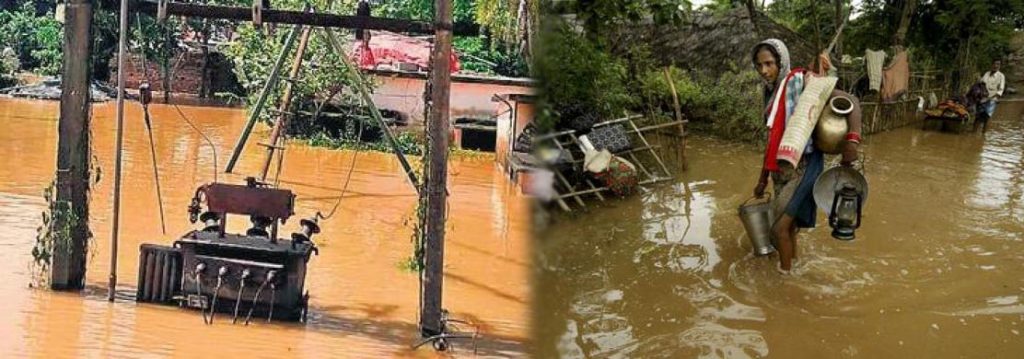Jajpur/Kendrapara: Three days after flood hit thousands of villages in Jajpur and Kendrapara districts amid swelling Baitarani and Mahanadi rivers, restoring electricity remains one of the biggest challenges for the district administration apart from facilitating essential services.
While flood is a regular affair in these areas, amid administrative apathy and lack of long-term planning, the current situation in the flood-hit villages appears to be a journey back in time.
Hundreds of electricity substations are submerged in floodwater leading to complete darkness in the flood-hit areas. It also means that telecommunication and several other essential services have come to a halt in these areas.
“We are marooned and this darkness has only increased our pain. Worse, with rising cases of snakebite during such times, the prevailing darkness poses a direct threat to our lives,” said Sambhu Pradhan from Serapur village under Bari block of Jajpur district.
Sambhu went on to explain how promises of long-term solutions were made in the past and nothing ever came of it.
With the rainy-day stocks gone in the floods, thousands of flood-hit villagers staying in temporary huts on river embankments is a common sight across these districts. Amid a severe lack of basic necessities such as food, drinking water and medicines, hoping and praying for floodwater to recede is the only thing they are counting on.
The condition of women in these makeshift tents is to be seen to be believed.
Many don’t have a cooking gas connection. Surrounded by floodwater as far as the eye goes, it is next to impossible for them to collect dry firewood as well. Worse, many families in these areas do not even have anything to cook. With local water bodies contaminated by floodwater, drinking water has become a luxury.
Women managing families with young kids and old men under such conditions is harrowing to say the least. Supply of medicines or availability of doctors in flood-hit areas amid the already stressed and corona-battered healthcare system is negligible, locals here said.
“It becomes very difficult and very unsafe after it gets dark. We have to either burn candles or lamps. Some of us don’t even have them and we share whatever we have among each other,” said Samuka Das from Namatara village in Rajkanika block of Kendrapra district.
Samuka is staying with her six-membered family in a temporary kutcha house near the river embankment.
“While past experience suggests that floodwater will eventually recede with or without administrative support, waterborne disease is something which will claim many lives who struggled and survived the flood,” Das added with a heavy heart.
Another woman here pointed to the issue of hygiene and sanitation. With most toilets now submerged under floodwater, open defecation is the norm. Residents realise how this can lead to further contamination, but they have no better choice.
Large parts of Aul, Rajkanika, Marsaghai, Garadapur and Pattamundai blocks in Kendrapara district are partly submerged and reeling under darkness from last three days.
According to Kendrapara district emergency officer Sambit Satpathy, as many as 2.6 lakh people in this district alone have been affected by the flood. Unofficial numbers are higher.
Picture, however, is pretty much the same everywhere.
That said, Satapathy claimed that the administration will try to restore power supply as the floodwater recedes.
Life, of course, will go back to normal with or without administrative help – until the next flood arrives.
PNN

